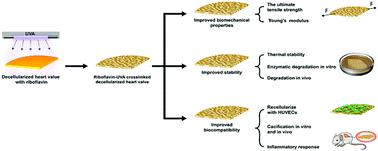当前位置:
X-MOL 学术
›
Biomater. Sci.
›
论文详情
Our official English website, www.x-mol.net, welcomes your feedback! (Note: you will need to create a separate account there.)
A riboflavin-ultraviolet light A-crosslinked decellularized heart valve for improved biomechanical properties, stability, and biocompatibility.
Biomaterials Science ( IF 6.6 ) Pub Date : 2020-05-06 , DOI: 10.1039/c9bm01956a Chungeng Liu 1 , Weihua Qiao 1 , Hong Cao 1 , Jinchi Dai 1 , Fei Li 1 , Jiawei Shi 1 , Nianguo Dong 1
Biomaterials Science ( IF 6.6 ) Pub Date : 2020-05-06 , DOI: 10.1039/c9bm01956a Chungeng Liu 1 , Weihua Qiao 1 , Hong Cao 1 , Jinchi Dai 1 , Fei Li 1 , Jiawei Shi 1 , Nianguo Dong 1
Affiliation

|
Tissue-engineered heart valves are a promising alternative to current valve substitutes. As the main scaffold of tissue-engineered heart valves, the decellularized heart valve (DHV) has problems such as biomechanical property damage and rapid degradation. In this study, we applied a photo-crosslinking reaction induced by riboflavin and ultraviolet light A (UVA) in the DHV for improving its biomechanical properties and stability. The results showed that the biomechanical properties of the DHV significantly improved following riboflavin-UVA (R-UVA) crosslinking. Moreover, the R-UVA-crosslinked DHV (R-UV-DHV) showed better resistance to enzymatic degradation in vitro, with significantly higher thermal denaturation temperature compared to that of the untreated DHV, indicating that the stability of the R-UV-DHV improved. Histological staining and scanning electron microscopy showed that the leaflet ultrastructure was preserved better after R-UVA crosslinking compared to a glutaraldehyde-crosslinked DHV. In addition, we found that the R-UV-DHV exhibited excellent human umbilical vein endothelial cell adhesion and cells could readily grow on its surface. In an in vitro anti-calcification experiment, the R-UV-DHV demonstrated non-calcifying properties in a simulated body fluid. Furthermore, the R-UV-DHV showed characteristics of slow degradation, non-calcification, and reduced pro-inflammatory response through a rat subcutaneous implantation model. As a result, R-UVA can effectively crosslink the DHV and the R-UV-DHV possessed satisfactory biocompatibility. R-UVA crosslinking can be a new approach for improving the performance of the DHV to prepare a better scaffold for tissue-engineered valves.
中文翻译:

核黄素-紫外线光A交联的脱细胞心脏瓣膜,可改善生物力学性能,稳定性和生物相容性。
组织工程心脏瓣膜是目前瓣膜替代物的有希望的替代方法。作为组织工程化心脏瓣膜的主要支架,脱细胞心脏瓣膜(DHV)存在诸如生物力学性质破坏和快速降解等问题。在这项研究中,我们应用核黄素和紫外线A(UVA)在DHV中引起的光交联反应来改善其生物力学性能和稳定性。结果表明,核黄素-UVA(R-UVA)交联后,DHV的生物力学性能显着提高。此外,与未经处理的DHV相比,R-UVA交联的DHV(R-UV-DHV)在体外对酶降解表现出更好的抵抗力,热变性温度明显更高。这表明R-UV-DHV的稳定性改善。组织学染色和扫描电子显微镜显示,与戊二醛交联的DHV相比,R-UVA交联后小叶的超微结构得以更好地保存。此外,我们发现R-UV-DHV表现出优异的人脐静脉内皮细胞粘附性,并且细胞可以很容易地在其表面生长。在体外抗钙化实验中,R-UV-DHV在模拟体液中显示出非钙化性质。此外,R-UV-DHV通过大鼠皮下植入模型表现出缓慢降解,不钙化和减少促炎反应的特征。结果,R-UVA可以有效地交联DHV,并且R-UV-DHV具有令人满意的生物相容性。
更新日期:2020-03-03
中文翻译:

核黄素-紫外线光A交联的脱细胞心脏瓣膜,可改善生物力学性能,稳定性和生物相容性。
组织工程心脏瓣膜是目前瓣膜替代物的有希望的替代方法。作为组织工程化心脏瓣膜的主要支架,脱细胞心脏瓣膜(DHV)存在诸如生物力学性质破坏和快速降解等问题。在这项研究中,我们应用核黄素和紫外线A(UVA)在DHV中引起的光交联反应来改善其生物力学性能和稳定性。结果表明,核黄素-UVA(R-UVA)交联后,DHV的生物力学性能显着提高。此外,与未经处理的DHV相比,R-UVA交联的DHV(R-UV-DHV)在体外对酶降解表现出更好的抵抗力,热变性温度明显更高。这表明R-UV-DHV的稳定性改善。组织学染色和扫描电子显微镜显示,与戊二醛交联的DHV相比,R-UVA交联后小叶的超微结构得以更好地保存。此外,我们发现R-UV-DHV表现出优异的人脐静脉内皮细胞粘附性,并且细胞可以很容易地在其表面生长。在体外抗钙化实验中,R-UV-DHV在模拟体液中显示出非钙化性质。此外,R-UV-DHV通过大鼠皮下植入模型表现出缓慢降解,不钙化和减少促炎反应的特征。结果,R-UVA可以有效地交联DHV,并且R-UV-DHV具有令人满意的生物相容性。



























 京公网安备 11010802027423号
京公网安备 11010802027423号